MAGICAL DWARKA

MAGICAL DWARKA The kings of Dwarka were Ugrasen, then Balarama. However, it’s Krishna who always truly led. Dwarka was made rich and thriving by Krishna’s created port. Vishwakarma, the godly architect, crafted the city, presenting a replica of Amaravati, the divine city. Land was scarce, so Krishna asked ocean god Samudra for twelve yojanas of land, which he gave. The location was once Kushasthali, but Krishna renamed it Dwaravati, meaning ‘gateway to moksha.’ The city sprung up where the Gomati River met the sea, boasting a ship harbor. Palaces, temples, gardens, and water pools filled this fortress city, thanks to Vishwakarma. Mahabharata and the Vishnu Purana extensively detail the city. Marble palaces with silver doors were made for Krishna’s three queens – Rukmini, Satyabhama, and Jambavati. Krishna’s palace featured coral pillars adorned with carvings and gemstones, such as sapphires and emeralds. Silk canopies dripped gold and pearls. Ivory furniture with gold inlays and jewelled lamps filled the rooms. Battle clouds hung over Dwarka. Kalyavahan, an ally of Jarasandha, chased the Yadavas there. Spotting the army approaching, Krishna went off alone to handle the situation. Drawing the attention of the Yavana king, Krishna led him to an isolated spot in the hills, then hid inside a cave. Kalyavahan found a sleeping king, Muchkunda, in the cave. This king had aided the gods and gained a boon from Lord Brahma; whoever disturbed his sleep would be incinerated. Kalyavahan woke up Muchkunda harshly, then was burnt to ashes. Krishna adopted cunning to combat Jarasandha. Jarasandha had held ninety-eight kings and planned to sacrifice them once he had one hundred. Krishna, Bhima, and Arjuna disguised themselves as Brahmins, entered Magadha, and Bhima eliminated Jarasandha through a wrestling match. Krishna and Balarama ruled Dwarka for thirty-six years. Krishna was a key player in the quarrels between the Pandavas and the Kauravas, leading to a terrifying battle at Kurukshetra. Krishna and Arjuna’s friendship plays a crucial role throughout and Krishna often provided sage advice.
Lord Krishna’s City-Dwarka
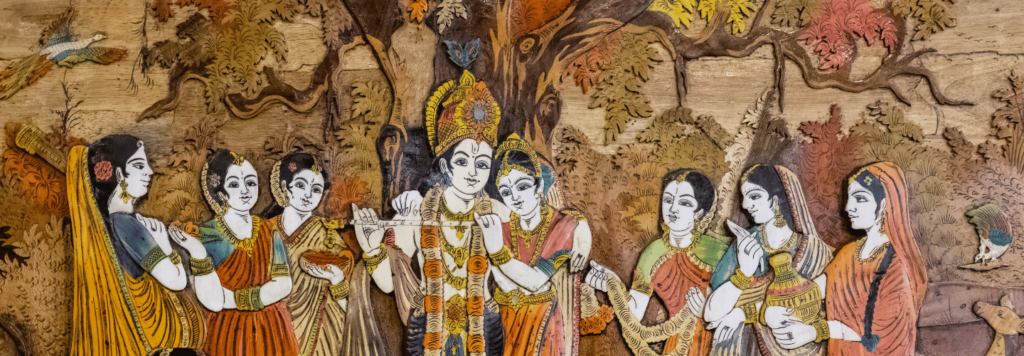
Lord Krishna’s City-Dwarka Lord Krishna moved his family from Mathura to Gujarat, coastal India. They created a city next to the sea, named Dwaravati or Dwarka. This city prospered as long as Krishna stayed and it disappeared beneath the ocean when he died, suggesting its existence depended on him. Dwarka never forgot Lord Krishna. His dynamic spirit still touches this peaceful coastal city. He is honored every day at the grand Dwarkadhish Temple with lamps, flowers, incense, and chants. Folks sing hymns and perform ecstatic dances. They consider him Dwarkadhish, the superior lord of Dwarka. Dwarka appears often in the scriptures of the “Mahabharata“. Here, many stories of the Pandava brothers from Hastinapur take place. Arjun often visited Krishna and ended up marrying Krishna’s sister, Subhadra. Different scripts, such as Harivamsa, Bhagavat Purana, Skanda Purana, and Vishnu Purana mention the city too. People believe it’s a place where you can attain spiritual liberation from the cycle of life and death. Although the ancient stones of Dwaravati are now deeply beneath the Arabian Sea, Krishna’s caring spirit invites every pilgrimage from across the country. Krishna’s Life Krishna grew up near the Yamuna River in Mathura-Vrindavan, in what we now call Uttar Pradesh. But why did he set up his kingdom so far away in Gujarat’s Dwarka? This epic journey of the Yadava tribe is an intriguing story from the Mahabharata. The plot thickens when Krishna and his older brother Balarama overthrew their wicked uncle Kansa, the self-made king of Mathura. Kansa had taken the crown and sent his own father Ugrasen to prison. Afterwards, Ugrasen was reinstated as king but the real ruler of Mathura was Krishna. This change in power made Mathura an enemy of Jarasandha, the mighty king of Magadha. His two daughters had married Kansa, so Jarasandha despised Krishna. Additionally, Jarasandha dreamed of ruling an empire and had captured many local kings. But Krishna and his Yadava warriors stood in his way. Despite losing to Krishna eighteen times, Jarasandha wouldn’t admit defeat. Krishna knew he could win again but the constant battles had worn his people down. As if things weren’t tough enough, Jarasandha’s partner Kalyavahan, the Yavana king, planned to attack from the west while Jarasandha readied his troops for a nineteenth attack from the east. To protect his people, Krishna decided to escape the repetitive battles. He led his tribe across North India to distant Saurashtra. Krishna picked a place to settle that was guarded by the sea on one side and round hills on the other. Dwarka was so safe that Jarasandha never threatened them again there. Krishna even earned a new nickname in Dwarka, Ranchhodji. ‘Ran’ translates to battlefield and ‘chhor’ means to quit. So Ranchhodji describes a king who left the battlefield.
TALE OF DURGA & SHUMBHA !

TALE OF DURGA & SHUMBHA ! Chanda and Munda hint to Shumbha that there’s something more significant than simple understanding. Even though they haven’t fully grasped The Devi (Self), they’re correct in their early opinions that She’s Incomparable; A Gem – The Finest, Someone Worth Pursuing. Any other wealth and beauties fall short when measured against The Devi (Self). While they’re attracted to The Goddess, they haven’t yet identified Her Holiness. Spurred by Shumbha‘s inherent desire to collect the best of the best, he aims to claim Her as his own, much like how people typically hope to own what they find appealing. Shumbha first sends Sugriva, a persuasive messenger, to win Her over. But can you grasp The Self just through smart words alone? No. However, that’s a common mistake people make after gaining some knowledge. Sheer fluency or scripture knowledge cannot close the gap between the Self and the false self.The Devi expects nothing less than a showdown between The Self (Devi) and the false self (Shumbha). Clearly, the false self doesn’t stand a chance. He would face His End at Her Hands. Essentially, The Devi demands nothing less than the sacrifice of the false self. What’s the way to reach the Ultimate Self without letting go of the mistaken-self? Sugriva, smooth as silk, doesn’t succeed as planned. He shifts his strategy. He warns of pulling Her by Her Hair. It’s common for people, out of habit, to try claiming their Self using ordinary methods.If smooth talking and diplomacy fail, people often resort to force!Grabbing , The Devi Pulled by The Hair, reminds us of how people usually enter spirituality. It’s as if they’ve discovered a precious gem and want to claim it! They start treating it like an asset, similar to any worldly goods. Instead of embracing a spiritual essence, they try to force spirituality into a worldly framework. But that doesn’t fly! Next, shumbha sends dhumralochana to get The Devi, by force if necessary. The name ‘dhumralochana‘ means ‘smoky vision’, suggesting a flawed viewpoint. Is success possible with such a blurred view? False wisdom, the result of flawed reasoning or distorted sight, vanishes like a puff of smoke before True Self (Devi).
Tale of Devi Mahatmya and Chanda-Munda

Tale of Devi Mahatmya and Chanda – Munda Chanda and Munda are the first to spot The Devi. They rush to Shumbha to share what they’ve seen. They describe to him a Goddess so stunning, her glow lights up the Himalayas. They sweet-talk Shumbha, reminding him of his vast wealth and might, all taken from the gods. Swelling Shumbha’s pride, they hint that a man of his riches and power deserves to have this gem among women. Many hold the mistaken belief that pravrtti ought to be avoided. At this level of spiritual practice, it’s important to understand that no single thing is inherently good or bad. Even aspects viewed as undesirable can be reshaped into something positive. This outlook aligns with the Shakta approach. Tantra affirms “One must rise by that which one falls” chanda and Munda are asuric as long as they serve Asmita, the false-self.It’s the very same chanda and munda, those two shifts of vrttis that first cause us to notice The Devi (The Absolute Self).That same pravrtti which can drag us into restraint can also draw us towards freedom, towards self-realization, albeit at first just as another aim to pursue. Similarly, the same nivrtti which can push us away from those things that could lead to pain can also inspire real separation or disinterest or sincere vairagya.The same chanda and munda, two shifts of vrttis, are what first make us aware of The Devi (The Absolute Self). The same pravrtti that can lead us into restraint, can also guide us to freedom, self-realization, though at first it might merely be another goal to chase. Likewise, the same nivrtti that might repel us from things that possibly result in pain can also spark genuine separation, disinterest, or earnest vairagya. Parvati living in the Himalayas implies that our physical form isn’t inactive, it’s a home for the Self, which lights up our mind and body. Even divine beings visit the Himalayas to praise this Divine Self. The mountain isn’t a static lifeless object. It’s a dwelling place for the Steady Self, the Constant Consciousness.
Who is Chand Mund ?

Who is Chand Mund ? What do these two asuras denote? chanda means ‘fierce’ or ‘passionate’ while munda denotes a ‘shaved head’. Generally a shaved head is symbolic of vairagya or withdrawal. Vairagya can be true dispassion or it can also be sensitive withdrawal due to a bad experience. In the latter case it is not genuine vairagya but only withdrawal due to hurt, a negative reaction to an unpleasant experience. Here munda being an asura, denotes reactive withdrawal from things that have been a source of suffering, not genuine vairagya. chanda denotes ‘passionate pursuit’ while munda denotes sensitive ‘introverted withdrawal’. Two distinct actions symbolize pra-vrtti and ni-vrtti, the duo of psychological and behavioral activity. These pair constitute the typical conduct modes. One involves an intense chase after sensual allures, while the other embodies a cautious pullback from past pain sources. The ‘Asmita‘ or ego mainly works in two key ways. It either pushes out (pra-vrtti) or pulls in (ni-vrtti). This false identity responds to outside things, whether they’re people or stuff, in these patterns.When I think back on past encounters with people or things, I react differently. If the memories are good, I passionately engage. But, if they’re bad or caused pain, I retreat. Sometimes, I might even grow to really dislike or even hate that person or object. So, you see, this chasing or running away are just ways we react to certain triggers. How we react to different things or people falls into these two categories and it can vary, it all depends on what we’re facing. This idea is symbolized by chanda, which stands for the active chasing, and munda, for pulling back and retreating.Just a heads up: Chanda and Munda, in terms of Pra-vrtti and Ni-vrtti, are not the same as Extraversion and Introversion. Extraversion and Introversion are simply psychological habits, not good or bad. On the other hand, Chanda and Munda symbolize raga (attraction or obsession) and dvesha (disgust or hatred). These are two of the five disturbing kleshas in Yoga psychology.
SEAL AND SHIVA OF INDUS VALLEY CIVILIZATION
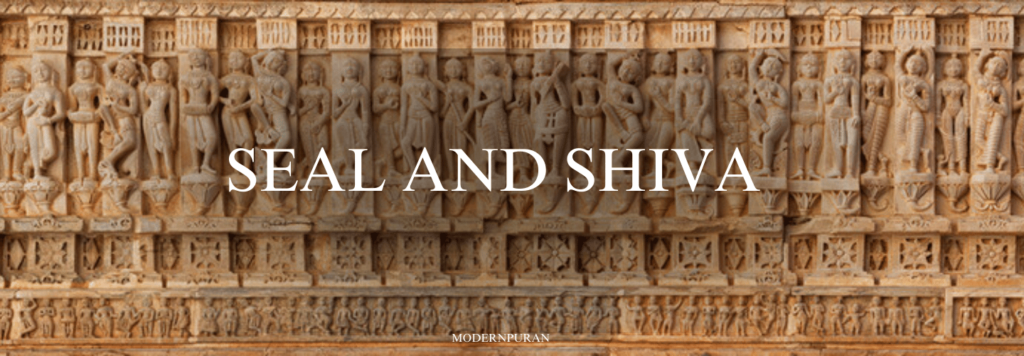
SEAL AND SHIVA OF INDUS VALLEY CIVILIZATION The mystery of the Indus Valley civilization fascinates many. Researchers tirelessly delve into the ancient era, studying old landmarks and artifacts to piece together the civilization’s history. A relic that propels this pursuit is the Pashupati Seal found in the ancient city of Mohenjo-Daro. The artifact’s varied interpretations provide insight into the civilization’s religious customs. This small relic holds powerful clues to the vast puzzle of the Indus Valley civilization. Measuring a mere 3.56 cm by 3.53 cm and 0.76 cm thick, the tiny seal is crafted from soapstone. The discovery was made in 1928-1929, with estimates placing the seal’s creation between 2350-2000 BCE. The seal’s central figure – a man with a horned headpiece – disrupts the norm of animals being the primary characters in Indus Valley seals. This man, perched on an elevated stage in a yoga pose, has three elongated, sharp-featured faces. His arms display a wealth of bangles stretching from wrist to shoulder, while necklaces cover his chest. Tassels on a belt adorn his waist. The intricate art of the Indus Valley civilization shows various plant-eating wild animals surrounding the seated man.Depictions of a rhino, an elephant, a buffalo, and a tiger, with the tiger appearing to attack the man, fill the seal. There are also two goats near the figure, their purpose – whether as animals or design elements of the platform – remaining unclear. Undeciphered Indus Valley civilization script adorns the seal. The seal’s purpose remains unknown but could have been a trading tool or an amulet, going by the hole seen on other seals. Thus, the seal might have been an identity marker for a community or worn as a status symbol. A number of historians have shared thoughts about a small seal’s scene. Most believe the human figure sitting is Shiva or Rudra, his other name. This idea came from John Marshall, an archaeologist and Director-General for the Archaeological Survey of India. He pointed out four reasons for his theory. First, the seated man’s three faces match some images of Shiva, who sometimes has four or five heads that look like three from the front. Second, the headpiece horns might depict Nandi, Shiva’s bull. Third, the man’s yoga pose links him to Shiva, who is seen as the first yogi and yoga’s source. Fourth, wild animals around the man might tie to Pashupati, another Shiva form known as ‘the animal king’, giving the seal its name. However, some have disagreed. Doris Srinivasan, Indian studies professor, argues the figure is a god that’s half man and half buffalo. She thinks the figure has cow ears, not three faces. Since their society relied on farming, cattle were essential, and a cattle god fits. Others have a slightly different idea. They believe the seal shows asura, a type of demon, rather than a god, but still half man and half buffalo. They say this could be a depiction of Mahishasura, a known asura who was defeated by Goddess Durga. Durga’s tiger, Dawon, might be the one attacking the figure in the seal. Some historians believe the figure might resemble gods from Vedic tales, such as Agni, Indra, and Varun. Leaving behind religious views, the seal also gives clues about yoga’s history in India. The figure’s pose, called Mulabandhasana, is a hard yoga posture. It demands flexible knees, hips, legs, ankles, and feet. Its presence on the seal of the Indus Valley civilization suggests advanced yoga was practised in the Indus Valley, indicating yoga may have started before or during their civilization.
God Of Harappa Civilization
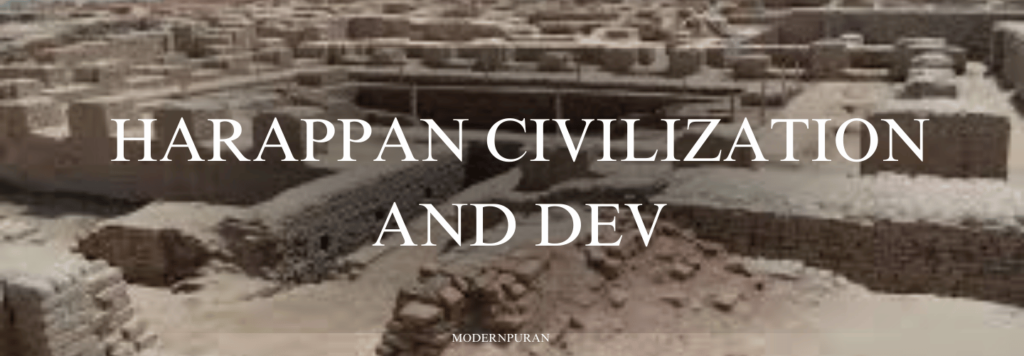
GOD OF HARAPPA CIVILIZATION The discovery of an ancient civilization was first made in 1921 at Harappa, located in the Punjab region. The next finding came the following year at Mohenjo-daro, located close to the Indus River, in the Sind region. Both of these historic sites are in what we now know as Pakistan, specifically within the Punjab and Sindh provinces. In recognition of its cultural significance, Mohenjo-daro earned designation as a UNESCO World Heritage site in 1980. PASHUPATI SEAL SHIVA Harappa ruins located in Punjab, Pakistan and other near-by areas. The harappa civilization’s trace was later found in distant locations such as Sutkagen Dor, situated in southwestern Balochistan province, Pakistan. This spot next to the Arabian Sea is roughly 300 miles west from Karachi. Findings also surfaced at Ropar (or Rupar), in the eastern Punjab state of northwestern India, situated at the base of the Shimla Hills, about 1,000 miles northeast from Sutkagen Dor. Subsequent voyages confirmed its existence stretching south along the west coast of India, right up to the Gulf of Khambhat, located 500 miles southeast of Karachi. Its presence further extended to the Yamuna River basin, located 30 miles north of Delhi. When compared, this civilization is the most extensive amongst the world’s three earliest civilizations, even though both Mesopotamian and Egyptian civilizations are thought to have begun a bit earlier. Yogic posture seal of harappa In the Harappa Civilization, Pashupati, an early form of Shiva, was worshipped. Found in Mohenjo Daro was the Pashupati seal. A three-faced figure, seated with an elephant, tiger, buffalo, rhino, and two deer, is depicted. It’s also called the Mahayogi seal and is an early Shiva depiction. Excavation leader, Sir John Marshall, labeled it ‘Proto Shiva.‘ The seal remains at New Delhi’s National Museum. The people also revered the Mother Goddess, Neem, Peepal, the Sun, Fire, Earth, and Water. These were important to Harappan Civilization’s beliefs. The Pashupati seal, or Mahayogi seal as it’s sometimes called, is an old stone seal found in what is now Pakistan, in an ancient city from the old Indus Valley civilization, known as Mohenjo-daro. This find happened between 1928-29 during British rule, by the Archaeological Survey of India, whose job it is to dig up and protect such things. The seal shows a seated figure who might have three heads. This figure is also maybe male but Jonathan Mark Kenoyer, still thought was right in a 2003 paper. The man wears a horned headdress, is surrounded by animals, and might even be a horned god. The Pashupati seal has a unique arrangement of these elements, but other seals from the Indus region do share some similarities. For example, another seal also found in Mohenjo-daro,which now resides in Islamabad, shows a similar horned three-faced figure seated in a meditative pose on a throne, wearing arm bracelets. However, in this case, there are no animals and people can’t agree if the figure is male or female, even if it looks like it has a beard. The seal carries the mysterious Indus Valley civilization script, yet to be decoded. The seal’s actual use remains uncertain. Some experts propose they assisted with commerce. Interestingly, many have a hole on the reverse side, hinting at use as charms. Consequently, the seal might represent a settlement’s community identifier or worn as a status symbol.
Indus Valley Civilization and Goddess
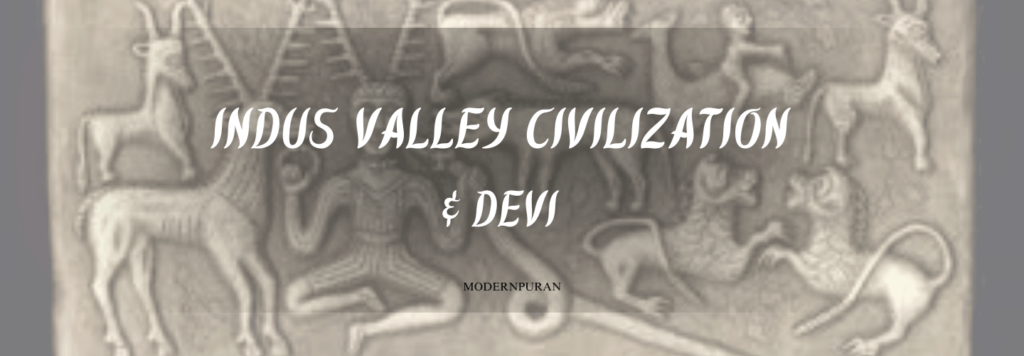
The Harappan Civilization, or the Indus River Valley Civilization, existed from 3300-1300 BCE. It stretched from what is now northeast Afghanistan to Pakistan and northwest India. They accomplished several notable advancements. These include setting standard weights and measures, creating seals through carving, and metalwork with materials like copper, bronze, lead, and tin. Although its script remains a mystery and relates to mythology , this means that the institutions and governance systems of the civilization also remain largely unexplored. Most evidence suggests that climate change and migration might have been the downfall of this civilization. The abundance of Indus Valley Civilization also holds its importance in mythology of Indian ancient history. I have created all worlds at my will without being urged by any higher Being, and dwell within them. I permeate the earth and heaven, and all created entities with my greatness and dwell in them as eternal and infinite consciousness. — Devi Sukta, Rigveda The Vedas mention many cosmic goddesses like Prithvi (Earth), Aditi (Cosmic moral order), Vāc (Sound), Nirṛti (Destruction), Ratri (Night) and Aranyani (Forest). There are also bounty goddesses like Dinsana, Raka, Puramdhi, Parendi, Bharati and Mahi mentioned and it serves the huge treasure to the Indian Mythology.But, gods (devas) get discussed more often than goddesses.Devi emerges in late Vedic texts that are pre-Buddhist it is also mention as devi tales in books of mythology of India, but her dedicated verses don’t suggest a fully developed character during the Vedic era. Standalone gods and goddesses existed in Vedic times, but in post-Vedic writings, especially in early medieval literature, all become aspects or manifestations of one Devi, the Supreme Power. People of the Indus Valley Civilization worshipped a female deity. They called her the Mother Goddess , also known as Shakti or Matridevi in mythological tales . She was important to them. Why? They believed she was the creator of all and linked her to motherhood and life’s continuation. She symbolized fertility and reproduction. As evidence – There are terracotta figurines and statues of the Mother Goddess. One such clay sculpture from around 2,500 BCE in Mohenjo-Daro is displayed in Delhi National Museum. It has a fan-shaped headdress and two necklaces. Also, there’s a large pannier cup and eye-like clay pellets. But the Mother Goddess wasn’t the only one worshipped. The people also venerated Shiva Pashupati, a male god and the animal lord. They also worshipped Shiva in Linga and Yoni forms.
Who Is Devi ?
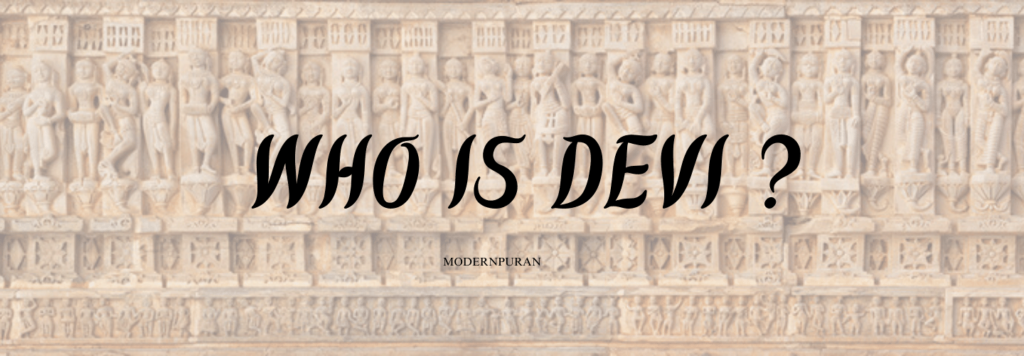
WHO IS DEVI …! In Hinduism, Devi holds a top spot, especially in the Shakta tradition. The Smarta tradition also recognizes her as one of Brahman’s five main forms. As seen in other traditions, Devi symbolizes the dynamic force of the Deva, always showing up together to complement each other. Examples include Parvati and Shiva, Saraswati and Brahma, Lakshmi and Vishnu, Sita and Rama, and Radha with Krishna. In numerous Hindu texts like the Devi Upanishad, the teachings echo Devi-centric philosophies. These touch on Shakti, essentially ascribing her the same status as Brahman, the ultimate reality. Shakti stands for both the material world (prakṛti) and consciousness (purusha). The text elaborates her as both joy and non-joy and everything that exists in the universe. Interestingly, Shakti is also identified as Parvati, the wife of Shiva.[23] Furthermore, in texts like the Tripura Upanishad, Bahvricha Upanishad and Guhyakali Upanishad, Shakti is mentioned as Shiva‘s creative power. Devi, in the Devi Upanishad, claims to be the ultimate truth, Brahman. She tells the gods that she governs the world, enriches believers, and is the highest divinity. All praise should go to her, and she breathes life into everyone. She boldly claims to have built earth and heaven, where she lives.Her making of the sky as a ‘father’ and the waters as the ‘mother’ shows her as the ‘Supreme Inner Self‘. There’s no superior entity that tells her to create; she is in everything she makes. She-Devi, is infinite, timeless consciousness. She holds earth and heaven and ‘all kinds of joy and sorrow, knowledge and misunderstanding, Brahman and Non-Brahman‘. Utilization of words like yantra, Bindu, bija, mantra, shakti, and chakra as tantric aspects in the Devi Upanishad. She is greatest entity in the entire mythology.
God Of Love – KamaDev

God Of Love – Kama Dev In the ancient Indian scripture Rigveda, we first meet Kamadeva (kamadev). His name joins ‘kama,’ meaning desire, and ‘deva,’ God, and thus he’s known as the ‘God of Desire’. An interesting way to picture him? Imagine a person flying on a parrot, holding a bow made from a sugarcane stalk. Now, think of the bow string – it’s a line of buzzing bees! As for his arrows, they’re not the usual ones. They’re flower-tipped, symbolizing desire. That’s Kamadeva’s unique way to spread love – those arrows can make anyone fall in love! Tale of Lord Shiva and kamadev Kamadeva was cursed by Shiva and was finally brought back to life only after Shiva and Parvati were happily married! There could be two reasons for this. For starters, Kamadeva was considered a part of the Vaishanava tradition, thought to be Vishnu and Lakshmi‘s son. Later on, Krishna took over as the ideal lover. Krishna, one of our most widely beloved gods, is perceived as the timeless lover alongside Radha and the gopis. In Mathura, there’s even a trace of a festival dedicated to the local god of love – Madana, that was absorbed by Krishna’s followers. There is celebration in the city that used to be the Madana Leela is now honored as Krishna’s Raas Leela! Kamadeva, a character dating back to the Rigveda, has a name that simply means ‘God of Desire.’ His description is vivid, involving him riding a parrot and holding a bow crafted from a stalk of sugar-cane. This bow is strung with a line of bees that hum. His arrows? They’re not your common ones. They’re flower-tipped, representing desire itself! Supposedly, their influence can make anyone fall in love! The Indian Kamadeva, the Greek God Eros, and the Roman Cupid share clear similarities in storytelling. The most outstanding story is when Kamadeva disturbed Lord Shiva‘s meditation to help Parvati, a king’s daughter, get his attention. Shiva, upset by the intrusion, lashed out at Kama with a curse. The love God returned to life once Shiva and Parvati tied the knot. It appears Kamadeva never truly bounced back as there aren’t many stories about him afterward.









